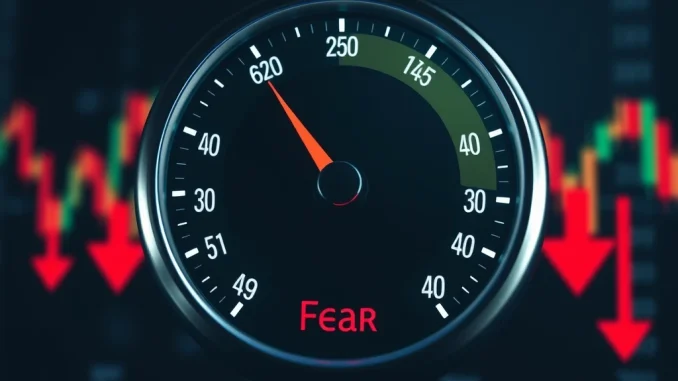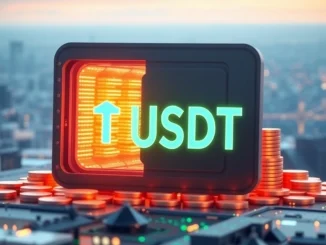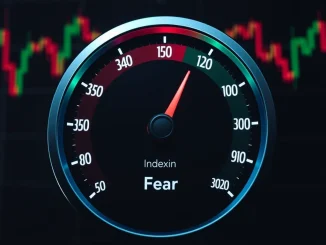
Is the crypto winter back? The latest readings from the Crypto Fear & Greed Index are flashing red, signaling a significant shift in market sentiment. Just yesterday, the index sat in ‘Fear’ territory, but today, it has taken a dramatic 14-point nosedive, plunging into the ‘Extreme Fear‘ zone at a chilling 25. What does this mean for your crypto investments, and should you be worried? Let’s dive deep into what’s driving this sudden wave of fear in the crypto markets.
Decoding the Crypto Fear & Greed Index: A Sentiment Thermometer
For those unfamiliar, the Crypto Fear & Greed Index, provided by Alternative.me, is a crucial tool for gauging the overall sentiment of the cryptocurrency market. Think of it as a sentiment thermometer for crypto. It operates on a scale of 0 to 100:
- 0 – Extreme Fear: This indicates investors are extremely worried, and could suggest a potential buying opportunity.
- 100 – Extreme Greed: This signals excessive optimism, which might precede a market correction.
A reading of 25 firmly places us in ‘Extreme Fear‘, a stark contrast to just yesterday’s ‘Fear’ level. This rapid shift raises critical questions about the immediate future of Bitcoin and the broader cryptocurrency ecosystem.
What Fuels the Fear? Unpacking the Index’s Components
The Crypto Fear & Greed Index isn’t based on guesswork; it’s a data-driven analysis incorporating six key factors to provide a comprehensive view of market sentiment:
- Volatility (25%): Measures the current and maximum drawdowns of Bitcoin, comparing it with the corresponding average values of the last 30 and 90 days. High volatility often breeds fear.
- Market Momentum/Volume (25%): Analyzes Bitcoin’s market momentum and trading volume relative to recent averages. Weak momentum can contribute to fear.
- Social Media (15%): Tracks sentiment trends on social media platforms, primarily Twitter, to understand public perception. Negative social sentiment amplifies fear.
- Surveys (15%): Conducts periodic crypto surveys to gauge investor sentiment directly. Bearish survey results naturally increase the fear index.
- Bitcoin Dominance (10%): Measures Bitcoin’s dominance in the overall crypto market. Increased Bitcoin dominance can sometimes indicate a flight to safety during fearful times.
- Google Trends (10%): Analyzes Google Trends data for Bitcoin-related search queries. Spikes in fear-related searches can correlate with market downturns.
The current plunge in the index suggests a confluence of negative signals across these factors, painting a picture of widespread anxiety among crypto investors.
Why is Market Sentiment So Weak Right Now? Exploring the Drivers of Extreme Fear
Several factors could be contributing to the current ‘Extreme Fear‘ gripping the crypto market. While the index itself doesn’t pinpoint specific causes, we can look at broader market dynamics:
- Macroeconomic Uncertainty: Global economic concerns, including inflation, rising interest rates, and geopolitical instability, often spill over into the crypto markets.
- Regulatory Scrutiny: Increased regulatory attention and potential clampdowns in various jurisdictions can create fear and uncertainty.
- Recent Market Corrections: Significant price drops in Bitcoin and other major cryptocurrencies can trigger panic selling and exacerbate fear.
- Negative News Flow: Bearish news headlines, exchange hacks, or project failures can further dampen market sentiment.
It’s crucial to remember that the crypto market sentiment is highly reactive to news and events. Understanding these potential drivers can help you interpret the Fear & Greed Index in context.
Navigating Extreme Fear: Is it Time to Panic or Strategize?
So, the Crypto Fear & Greed Index is flashing ‘Extreme Fear‘. What should you do? It’s definitely not the time to make rash, emotionally driven decisions. Instead, consider these strategic approaches:
- Don’t Panic Sell: ‘Extreme Fear’ often presents buying opportunities for long-term investors. Selling in panic can lock in losses.
- Review Your Portfolio: Assess your risk tolerance and portfolio allocation. Are you comfortable with the current level of volatility?
- Do Your Own Research (DYOR): Don’t rely solely on sentiment indicators. Conduct thorough research on the projects you’re invested in.
- Consider Dollar-Cost Averaging (DCA): If you believe in the long-term potential of crypto, DCA can be a strategy to accumulate assets gradually during market downturns.
- Stay Informed: Keep abreast of market news, regulatory developments, and macroeconomic trends that could impact crypto.
Remember, market cycles are inherent in crypto. Periods of ‘Extreme Fear‘ have historically been followed by periods of recovery and growth. The Fear & Greed Index is a valuable tool, but it’s just one piece of the puzzle.
Harnessing Crypto Analysis: Turning Fear into Opportunity
Instead of succumbing to fear, sophisticated investors use crypto analysis to understand market dynamics and identify potential opportunities. Here’s how you can leverage analysis during times of ‘Extreme Fear‘:
| Analysis Type | Focus | Benefit During ‘Extreme Fear’ |
|---|---|---|
| Technical Analysis | Chart patterns, trading volume, indicators | Identify potential bottom formations and entry points. |
| Fundamental Analysis | Project fundamentals, technology, adoption, team | Assess the long-term viability of projects amidst market turbulence. |
| Sentiment Analysis | Social media, news, forums, Fear & Greed Index | Gauge overall market mood and potential turning points. |
| On-Chain Analysis | Transaction data, wallet activity, network metrics | Gain insights into network health and investor behavior beyond price action. |
By combining different forms of crypto analysis, you can move beyond emotional reactions and make informed decisions even when the market is shrouded in fear.
Bitcoin Volatility and Fear: An Inseparable Duo?
Bitcoin volatility is often cited as a major contributor to market fear. Indeed, the Fear & Greed Index incorporates volatility as a significant factor. Bitcoin’s price swings can be dramatic, and during periods of high volatility, fear tends to escalate.
However, it’s important to recognize that bitcoin volatility is a double-edged sword:
- Downside: High volatility can lead to significant losses, especially for inexperienced traders. It fuels fear and uncertainty.
- Upside: Volatility also presents opportunities for profit. Traders and investors can capitalize on price swings. Historically, periods of high volatility have preceded periods of substantial growth in the crypto market.
Understanding bitcoin volatility and managing risk are crucial skills for navigating the crypto space, particularly when the Fear & Greed Index signals ‘Extreme Fear‘.
Conclusion: Navigating Fear and Finding Opportunity in Crypto
The Crypto Fear & Greed Index‘s plunge into ‘Extreme Fear‘ is undoubtedly a concerning signal, reflecting weakened crypto market sentiment. However, it’s crucial to remember that fear is often a lagging indicator and can present contrarian investment opportunities. By understanding the factors driving fear, leveraging crypto analysis, and managing risk effectively, you can navigate these turbulent times and potentially position yourself for future market recoveries. Don’t let fear paralyze you; use it as a prompt to reassess, strategize, and make informed decisions in the dynamic world of cryptocurrency. The crypto market is known for its cycles, and ‘Extreme Fear‘ may just be the prelude to the next wave of growth.



